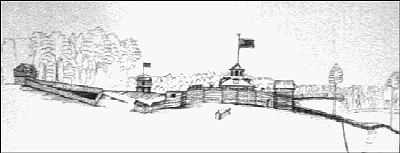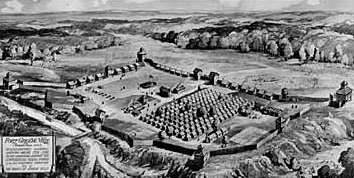

In 1791, after Harmar's defeat, President Washington called Arthur St. Clair to Philadelphia. St. Clair was the Governor of the Northwest Territory. Washington, and Secretary of War Henry Knox, gave orders to St. Clair to advance northward from Ft. Washington (Cincinnati) to the Miami Village of Kikionga (present site of Ft. Wayne, Indiana). He was to build a series of forts to protect settlers from Indians in the Northwest Territory.
St. Clair's plan was to form an army of 3,000 men and to advance on the estimated 1,000 to 2,000 Indians in the territory. St. Clair was overly confident and had visions of Indians running in fear when his army approached. Unfortunately, his army was comprised of poorly trained and equipped soldiers. Their numbers totaled just over 2,000 when they left Ft. Washington on September 17, 1791.
The Indians, primarily lead by Little Turtle of the Miami and Blue Jacket of the Shawnee, were well prepared, well informed by their scouts and motivated because they were fighting for their homeland. British supplies also supported them.
As St. Clair's army moved northward, it experienced a steady stream of desertions. The weather was turning cold and the army was equipped for summer fighting, as they originally planned to leave Ft. Washington in the spring. St. Clair, who was warned by Washington to be wary of surprises, virtually ignored reports of Indian scouts that were seen near his army. He brushed off these reports as just random Indians in the woods, not as a well-organized spy network.
Little Turtle and Blue Jacket were receiving a constant flow of information about the American army's location, numbers and supplies from these scouts. They were also receiving information from captured deserters.
 |
| Ft. Jefferson |  |
| Ft. Greenville |
St. Clair's army was reduced to just about 1,400 by the end of October due to the deserters and men killed by small groups of Indians that continually harassed the army on it's journey northward.
The Indian army of 1,000 left Kikionga and prepared to meet St. Clair in battle.
On November 3 St. Clair's army stopped to camp for the night at the mouth of the Wabash River. They encamped on an elevated piece of land they felt was good to defend if necessary.
Prior to dawn the next morning, the Indians had the American army virtually surrounded and they attacked. The route lasted nearly three hours before St. Clair and the survivors fled to Ft. Jefferson. St. Clair lost nearly 700 men, while the Indians lost about 40.
When word of the defeat reached President Washington, he exclaimed:
St. Clair resigned his commission, but remained as Governor of the Northwest Territory.
The Indians did not take advantage of their decisive victory, instead the various tribes separated with a vague notion of regrouping in the spring. The British also missed an opportunity to reclaim a foothold in the Ohio territory because word of the Indian victory did not reach England until the spring of 1792.